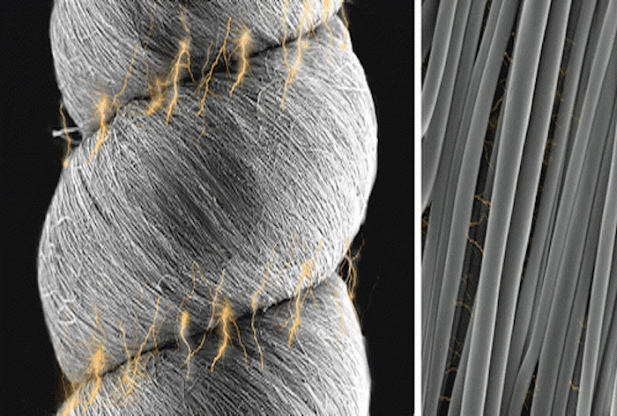

Scientists at the University of Texas, Dallas, have created fibers tougher than Kevlar. This awesome feat was accomplished by stretching the material in order to exploit piezoelectric effects to strengthen the attraction between molecules in the fiber. If you don’t know, the piezoelectric effect is the term used when pressure is converted into electrical charges. Ultimately, this process increases the amount of energy that a material can absorb before it fails.
And this new material can absorb up to 98 joules per gram, compared to Kevlar’s 80 joules per gram.

Kevlar may be best known for its use in bullet-proof vests, but since its discovery in the 1970s it has found broad applications as the material behind everything from sneakers, to speaker cones, and even rope.
The discovery of Kevlar was more or less accidental, but the UT-Dallas team went looking for fibers which could make use of the piezoelectric effect after noting a similar action occurring in collagen fibers found inside human bones. Instead of collagen, however, the team spun their nano fibers out of polyvinylidene fluoride (PVDF), a thermoplastic fluoropolymer of vinylidene fluoride. PVDF has been known to exhibit strong piezoelectric properties since the late 1960s and is primarily used in battery and sensor applications.
PVDF generates an electrical charge when stretched, and the fibers created by the team can stretch up to seven times their original length. The nanofiber is twisted as it stretches, forming microscopic yarns of the material.
The electricity generated in the process created a force 10 times stronger than a hydrogen bond in the nanofiber. The end result of the strength renders the fibers even more capable of absorbing physical energy than Kevlar.
Although the team has been successful in creating yarn-like structures from the nanofibers they have yet to demonstrate that it can be woven into larger mats or cords of material. That step will be necessary before more practical large-scale applications can be tested.
The applications will probably be similar in some cases to Kevlar: a self-reinforcing fiber which will be used for producing body armor and ultra-tough, but lightweight, components for high-stress structures in vehicles or airplanes. PVDF is abrasion-resistant as well, and is sometimes used currently for specialty monofilament fishing line.
From Quarks to Quasars is two people, Jaime and Jolene. We want to make the world a more sciencey place. We’re doing that, but with your help, we can do even more.
FQTQ takes a lot of time, money, and effort. Here, you can support us, get to know us, and access extra content: